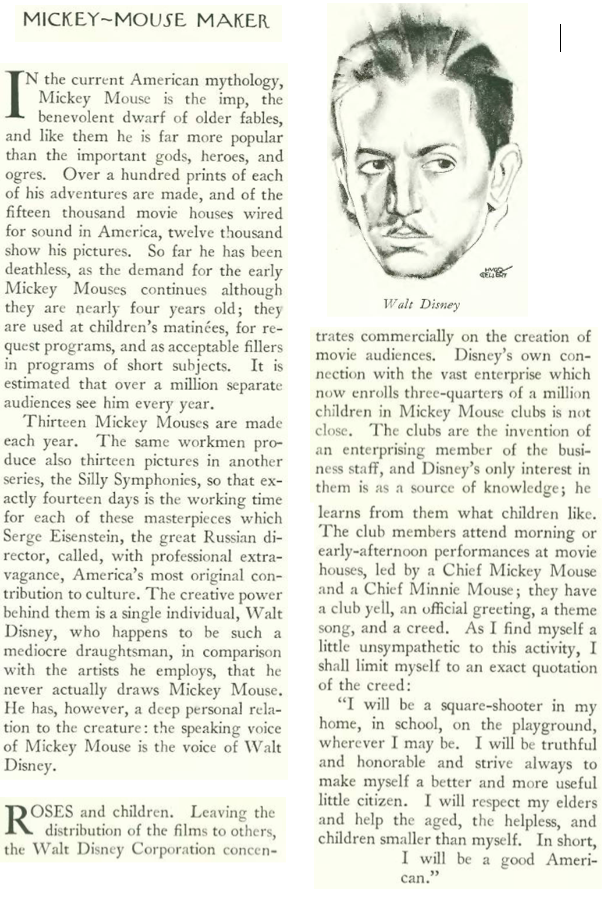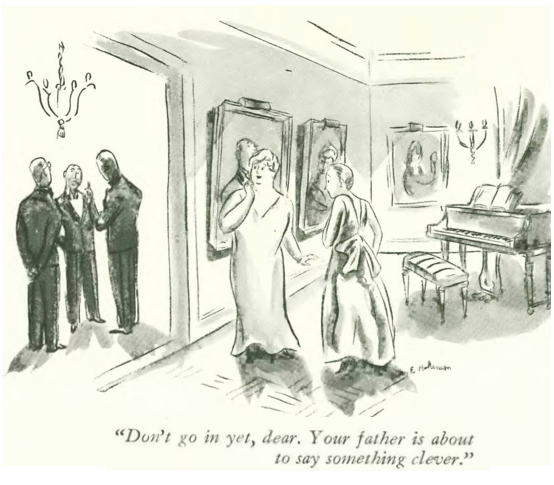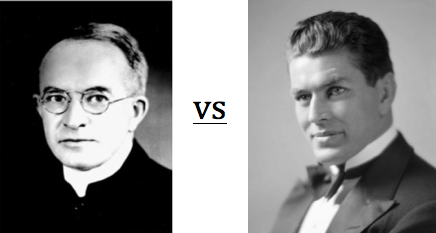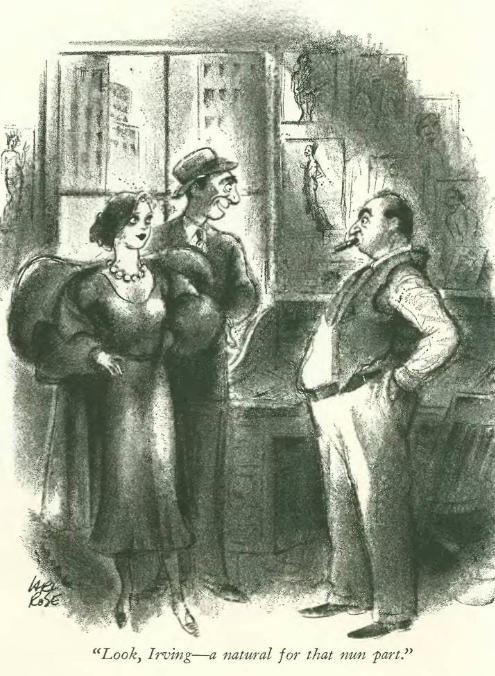In the spring of 1928, Walt Disney collaborated with cartoonist Ub Iwerks in creating a new cartoon character, Mickey Mouse, and later that year Mickey would be featured in the first-ever post-produced sound cartoon, Steamboat Willie. The film was an immediate hit, bringing almost instant fame to Disney.

Just three years after the birth of Mickey, Disney had already carved a place for himself in American culture, drawing the attention of millions of Mickey fans—and one critic for The New Yorker—Gilbert Seldes, who penned a profile of the “Mickey-Mouse Maker” (illustration by Hugo Gellert). Note in the second of these two excerpts how Disney was already connecting his product to patriotism and clean living through his Mickey Mouse Clubs:


In his conclusion, Seldes marveled at Disney’s productivity—a new picture made every two weeks—and his seemingly endless creativity. Little could Seldes imagine that one day the man and his mouse would become a multinational mass media and entertainment conglomerate.

You can watch 1931’s Traffic Troubles here:
* * *
Big Man on Canvas
It seems the earth almost shook when Mexican artist Diego Rivera arrived in New York for only the second one-man show at the Museum of Modern Art. His work habits, his comings and goings, and his enormous girth (modest by today’s standards) were reported in The New Yorker, including this entry in “The Talk of the Town”…


* * *
Winds of War
It’s the end of 1931, but one can already detect the rumblings of the future to come, namely world war. The former Allied and Axis powers of the First World War were all busy developing new weapons, particularly of the airborne variety that all believed would provide a decisive edge if (or rather when) the next war commenced. Japan was already making moves on China, and in just four years the Germans would reoccupy the Saarland and Italy would invade Ethiopia. E.B. White, in his “Notes and Comment,” found the current state of affairs more than a bit troubling…

…and hints of the world to come could also be found in Howard Brubaker’s “Of All Things” column, where he made this observation:
Brubaker was likely referring to Franklin D. Roosevelt’s cautious approach to announcing his candidacy for president. The outcome, of course, proved quite different for the German people.
* * *
From Our Advertisers
Preparations for war drove the development of the aircraft industry, which quickly adapted its designs during peacetime for civilian purposes. This ad from United Airlines touted the advantages of plane over train travel for corporate executives. Within 30 years the airlines would indeed supplant railroads as the preferred means for business travel…
…Prohibition would remain in force until the end of 1933, so brewers like Anheuser-Busch continued finding ways to link their non-alcoholic products to the ghosts of drinking past…
…on to our cartoons, James Thurber rendered this apt portrait of our civilization…
…Barbara Shermund gave us an actress with a reputation to protect…
…and Garrett Price presented an unlikely harmonica player…
…on to our next issue, where we find more Diego Rivera…

…and we begin with this entry from “The Talk of the Town,” attributed to James Thurber…


Thurber refers to “a lady” who accompanied Rivera, most likely Frida Kahlo, who was emerging as an artist in her own right around this time.
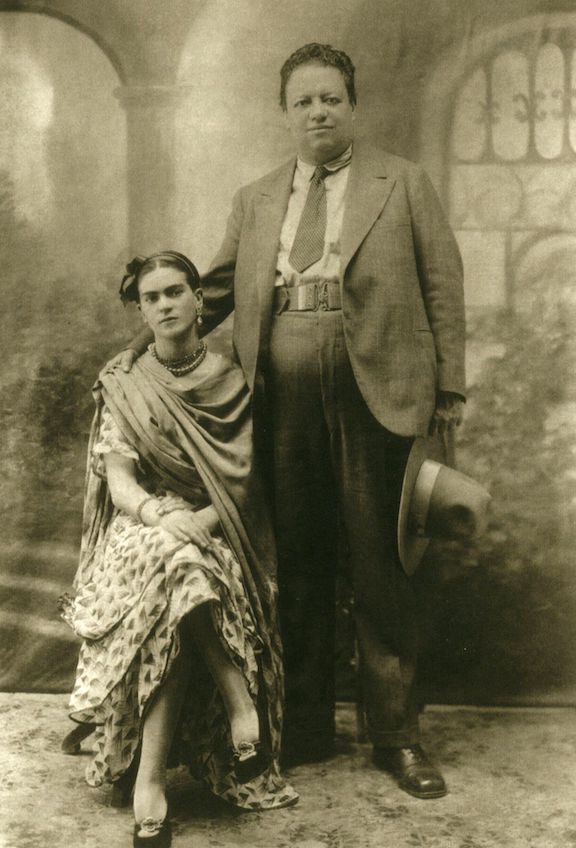
More on Diego could be found in the art review section, where critic Murdock Pemberton offered a cautionary message to the rabble who might not abide some of the artist’s controversial themes:
* * *
Head Cracker
In the 1920s and 30s Johnny Broderick was known as New York’s toughest cop, known for personally assaulting gangsters (and suspects) and for once facing down armed gunmen during a prison break at the Tombs. His valor won him many fans (and some detractors), making him a local celebrity and a subject of gossip columns. Reporter Joel Sayre offered his assessment of Broderick in a “Profile” for the Dec. 26 issue (illustration by Abe Birnbaum). Excerpts:

* * *
Something to Cheer About
On the lighter side, Hollywood took a shot at Noel Coward’s 1930 comedy of manners, Private Lives. The original play featured Gertrude Lawrence and Laurence Olivier, while the Hollywood version Norma Shearer and Robert Montgomery. For once, critic John Mosher actually liked this screen adaptation:

* * *
From Our Advertisers
Just one ad from the Dec. 26 issue to close out the year, and what better way to say “Merry Christmas” than with a fresh cigarette…
…on to our cartoonists, William Crawford Galbraith offered a look backstage in this two-page illustration across the bottom of “The Talk of the Town”…
…Richard Decker showed us the importance of making oneself clear, especially when aloft in a dirigible…
…Robert Day found humor in a barren landscape…
…Garrett Price offered us a cheesy predicament…
…Helen Hokinson found a man about to make an important point…
…and we end 1931 with this classic from James Thurber…
Next Time: Thurber’s Dogs…

